Windermere's Chief Economist, Matthew Gardner, explains how a strong, stable housing market is critically important to the overall U.S. economy.
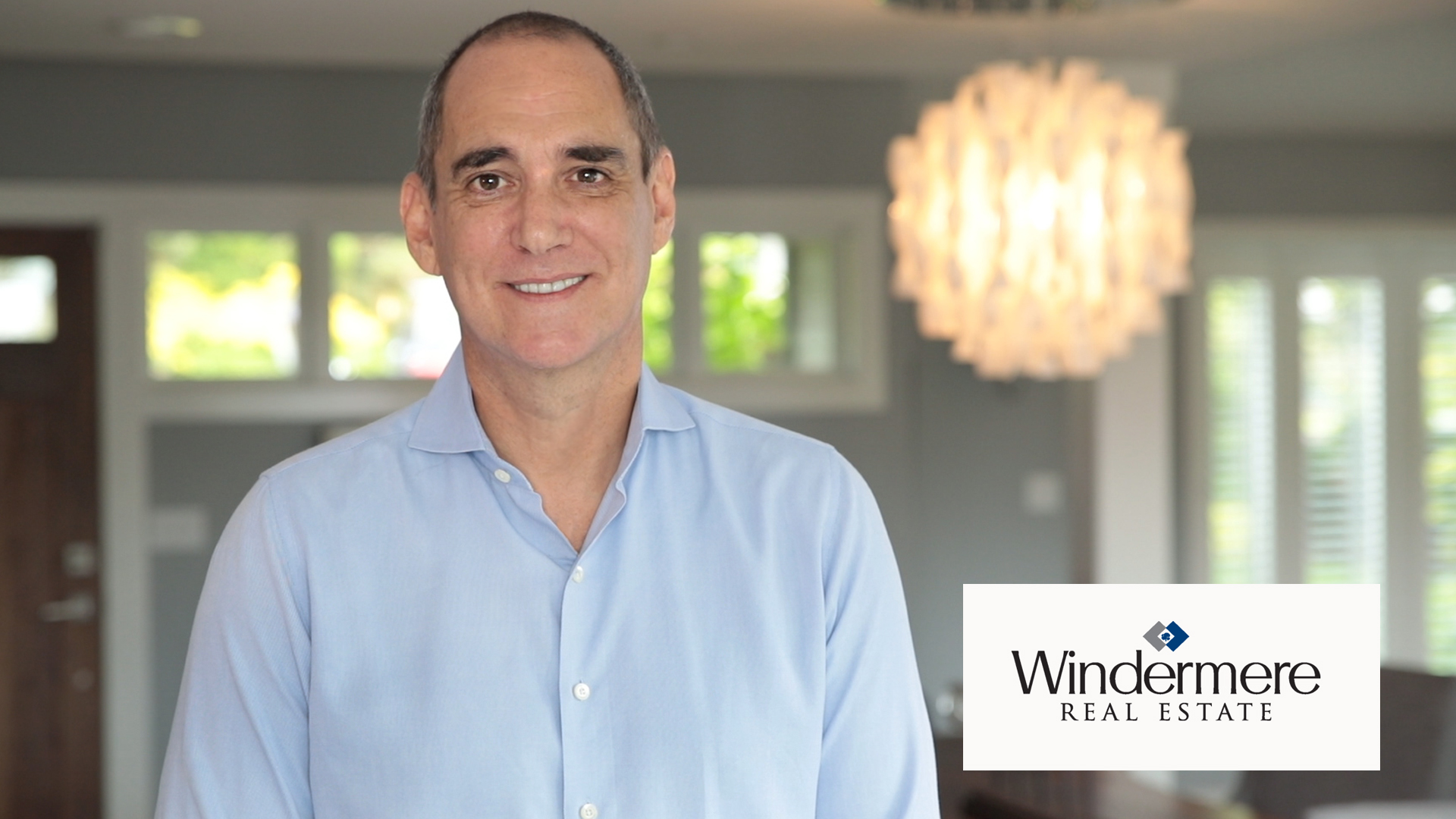
Windermere's Chief Economist, Matthew Gardner, explains how a strong, stable housing market is critically important to the overall U.S. economy.


According to a 2017 back-to-school survey, parents will spend an average of $501 per child on school supplies, clothes and accessories, computers and hardware, and electronic gadgets for the school year. For school supplies alone, the average spend per child is $104, which can be a lot for parents who are having difficulties just trying to make ends meet.
Thankfully, through donations from the Windermere Foundation, many of our Windermere offices are able to support local nonprofit organizations that provide backpacks, supplies, and other back-to-school necessities to children and families in need. Some offices have even made this an annual giving/volunteer event.
These are just a few of the Windermere offices that volunteer their time and donate funds to support programs that help children whose families would otherwise be unable to afford the basic necessities for the school year.
El Sobrante, CA
On July 15, the Windermere El Sobrante office kicked off their annual back-to-school supply drive with an ice cream social at their office. At the event they collected backpacks, school supplies and other donations, and provided ice cream for attendees. The drive ran from July 11 through August 10. Office staff also shopped for additional backpacks and supplies. Backpacks were then filled with supplies according to age, and delivered to three local area schools to distribute to students in need at the beginning of the school year.
Helena, MT
From June 26 through August 18, the Windemere Helena office supported The Angel Fund’s 11th Annual Stuff the Bus school supply drive. Agents purchased school supplies to fill up a bin at their office. This is the first year that the office has supported this drive. Students in need from over 30 schools in Helena and surrounding areas benefitted from this event.
Seattle, WA
For the past six years, the Windermere Mount Baker office has supported the Seattle/King County Coalition on Homelessness’s Project Cool back-to-school supply drive by holding drives to collect school supplies, and by participating in their annual backpack-stuffing event. This year, the office made a $1,000 donation to Project Cool through the Windermere Foundation, and 18 Windermere agents, staff, and family members volunteered on July 18 where they stuffed 100 of the 1,100 backpacks provided that day. The stuffed backpacks were delivered to various local social service organizations and homeless shelters, to be distributed to children in need.
 Generous donations from Windermere owners, agents, staff, and the community continue to make it possible for the Windermere Foundation to support programs like Project Cool. If you’d like to help children in need in your community during the school year, or throughout the year, please consider donating to the Windermere Foundation. To learn more about the Windermere Foundation, visit http://www.windermere.com/foundation
Generous donations from Windermere owners, agents, staff, and the community continue to make it possible for the Windermere Foundation to support programs like Project Cool. If you’d like to help children in need in your community during the school year, or throughout the year, please consider donating to the Windermere Foundation. To learn more about the Windermere Foundation, visit http://www.windermere.com/foundation
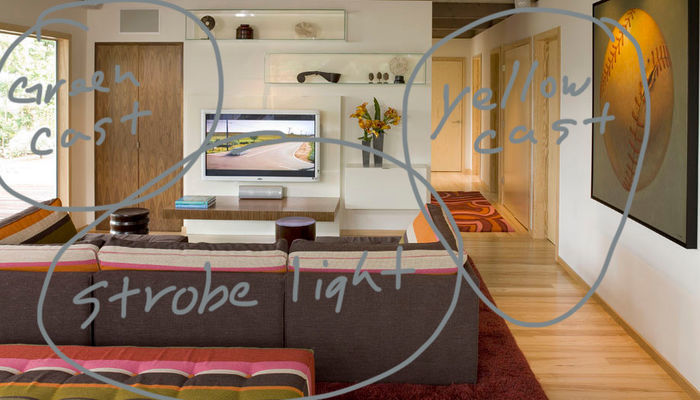
Homeowners and designers know what a difference color makes in a home. They can spend hours poring over print and online images in search of the perfect hue. But sometimes the color in the image doesn't end up looking the same on the wall. Why?
"Have you ever bought a piece of clothing online, thinking it's one shade of a particular color, only to find that it's completely different when it arrives?" asks photographer Christopher Stark. "Same goes for photos." We talked with Stark, photographer David Duncan Livingston and designer Jean Verbridge to get the scoop on how you can find and get the perfect color for your walls.
Color 1: David Duncan Livingston, original photo on Houzz
What makes a color look different from space to space? The ambience, look and feel of a color are highly dependent on an area's light and surroundings. The quality of the light in the room and how it hits each object makes a big difference. "The light can create color casts that change the appearance of the colors," says Livingston. "Think of the coolness of fluorescents or the warmth of incandescents."
"I usually pick the final color based on the time of day I'll be spending the most time in that room," says Verbridge. "It's also easier and less expensive to purchase small paint samples instead of painting an entire room and finding out you don't like the color."
Furniture, trim and accessories can change the look of a color from one room to another as well.
Related: Consult a Professional Painter First
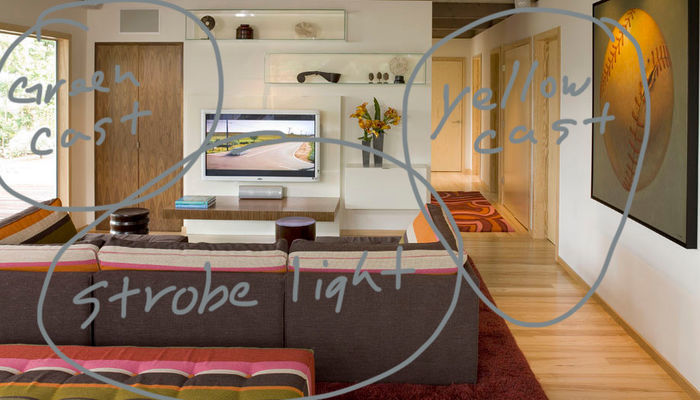
Color 2: David Duncan Livingston, original photo on Houzz
Why do colors look different in photos and online? The changes in color and light in different rooms are captured in photos — and often are more exaggerated, as Livingston illustrates here. While most professional photographers work to correct these color shifts and make the colors clearly, the photos will show up on different devices in different ways. "When an image is reproduced on a laptop, a magazine page or a photographic print, each of the outputs is slightly different, and the colors may shift a bit," says Livingston.
Photographers set their monitor colors to the same calibration, which allows them to get very close with color accuracy in postproduction. But the same standard doesn't apply to other devices. "Most consumers are not looking at things on a calibrated monitor," says Stark. "I wouldn't make a major decision that isn't reversible without seeing [the color] in person."
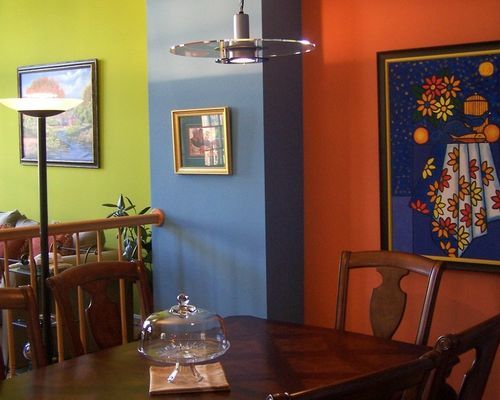
Color 3: Contemporary Dining Room, original photo on Houzz
How do I get a color I love online into my home? While Verbridge doesn't recommend going with a color listed online or in a magazine — since your own light will likely make it look very different in your space — there's still a way to get the hue you're looking for: Get a hefty supply of paint chips to find a match. "Put the color match next to the photo on your screen and squint your eyes. If the two can blur together, you have a match," says Livingston. Try a few samples from that same paint strip to test in your room to find the best one for your room's lighting and surroundings.
Related: A Color Guide for Every Room in the House
By Vanessa Brunner, Houzz

The housing market is remarkably tight across the U.S., and you may be wondering if you should wait for home prices to slow before making your move. Windermere's Chief Economist, Matthew Gardner, shares why waiting could end up costing you more money in the long run.
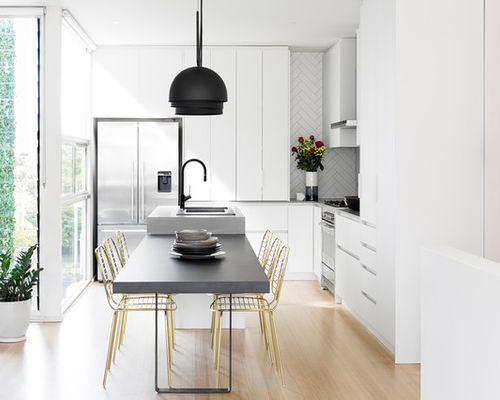
White-on-white kitchens have been a classic look for many years. Why does this trend endure? For starters, white connotes cleanliness, makes small spaces appear larger, and brightens rooms that are naturally dark.
Although many all-white kitchens are just lovely, some can appear a bit stark or cold. To help clients warm up their white, I recommend a variety of strategies, such as mixing metals and adding contrasting paint, fabric or wood. Read on for inspiration for personalizing your white kitchen so that it stands out from the crowd.
White Kitchen 1: Allard Ward Architects, original photo on Houzz
1. Warm metal accents. Copper, bronze, brass and polished nickel are just a few of the metals that can warm up an all-white kitchen. The gold sconces above the window and the white pendant lights, with their subtle hint of gold, add warmth and a touch of luxury to this all-white kitchen.
Related: Kitchen Lighting in Copper, Bronze, Brass, and Nickel
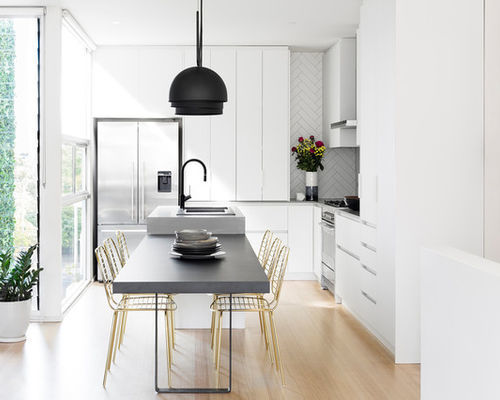
White Kitchen 2: GIA Bathroom & Kitchen Renovations, original photo on Houzz
2. Color and metal. Moving beyond metallics alone, a single contrasting color when combined with metals can create drama in a white kitchen. In this photo, a modern white kitchen intermingles black pendants and countertops with gold seating. This combination contributes to the room’s sleek contemporary look.
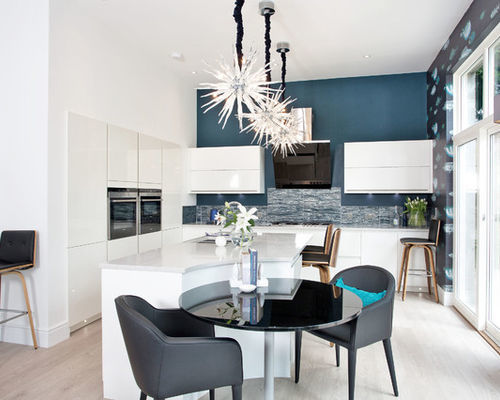
White Kitchen 3: Orchid Newton Ltd, original photo on Houzz
3. Wallpaper. I love wallpaper, especially in kitchens. Wallpaper can introduce color, movement and dimension to a white kitchen. When applied to a lone wall, wallpaper can create a dynamic focal point, as shown in this photo. The bright white cabinets and crisp white walls are softened by the shades of blue in the fish swimming on the side wall. This kitchen’s under-the-sea motif is enhanced by the blue tile on the back wall and the sea urchin-shaped pendant lights.

White Kitchen 4: IS Architecture, original photo on Houzz
4. Colorful island. Wood-stained islands often appear in white kitchens because of the richness and contrast they bring. This kitchen shows a creative alternative, pairing a chartreuse island with a chartreuse Roman shade. Together they lend a whimsical, personalized feel. To give your white kitchen a personal touch, consider painting your island your favorite color.
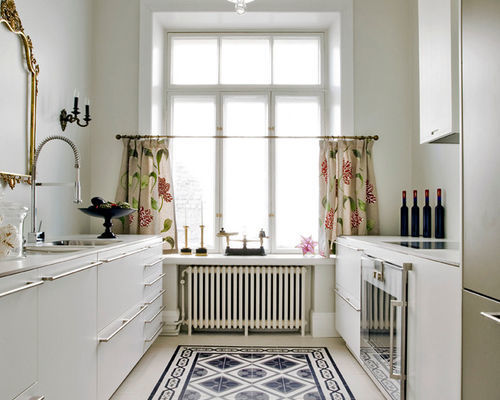
White Kitchen 5: Mosaic del Sur, original photo on Houzz
5. Tile rug. Layering in a rug is a great way to introduce color and texture to an all-white kitchen, but some clients worry that a rug could be an added source of dirt as well as a possible tripping hazard.
This clever kitchen resolves both issues with a tile rug instead of a fabric one.
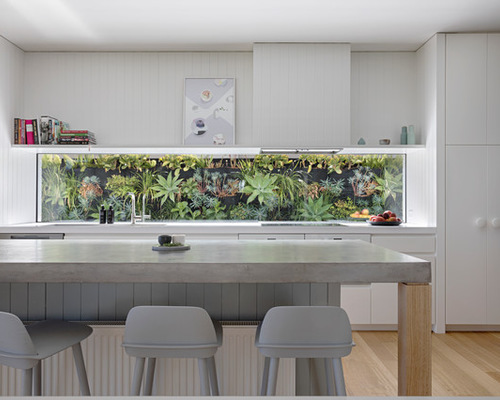
White Kitchen 6: Hindley & Co, original photo on Houzz
6. Backsplash. A tile backsplash also can bring color and texture to your white kitchen. But who says a backsplash must be tile? This kitchen has a counter-level window in lieu of a tile splash. The window faces a luscious succulent garden, thus creating a green vista for an otherwise monochromatic kitchen.
By Barbra Bright, Houzz
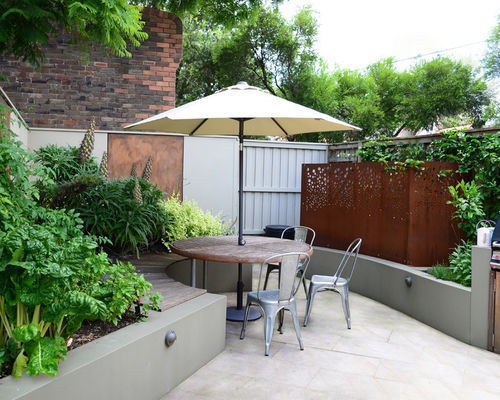
You probably don’t give much thought to your garbage cans, other than remembering to put them out on the right day. But we all have to store our trash and recycling bins somewhere, and doing so can be a challenge on a smaller property, especially if you don’t want them to be an eyesore. If you’re struggling to find a stylish way to store your bins, check out these smart and inspiring ideas. Now, is it black or green bin day this week?
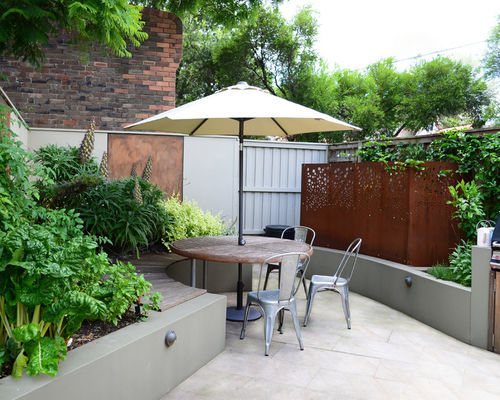
Garbage Bins 1: Outhouse Design, original photo on Houzz
Choose a screen. The curved screen in the corner of this courtyard is an attractive feature in its own right, thanks to the decorative cutwork pattern, and offers an elegant way to hide ugly plastic bins from view.
By using a screen like this, you can section off as much of the garden as you need — to store bikes or garden equipment as well as bins. To blend in the structure even further, you could grow climbers up and over the screen or along the wall behind.
Related: Outdoor Chairs to Entertain in the Garden
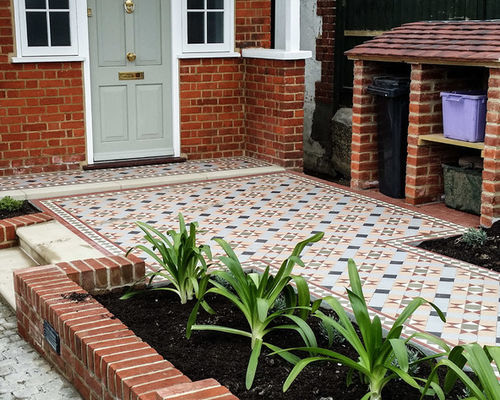
Garbage Bins 2: London Front Gardens, original photo on Houzz
Create a brick shelter. Built in red brick to match the house, and tiled with slate, this practical storage area blends with the property’s exterior and actually enhances the space with its character and interest. The look is mirrored in the raised bed at the front of the drive for a coordinated finish.
A custom compartment on the left neatly houses the bin, while two smaller storage compartments on the right make room for stacking recycling boxes.
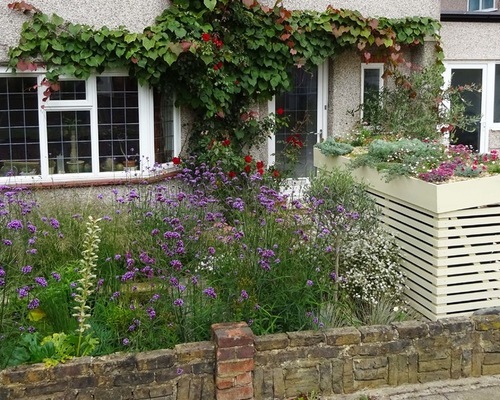
Garbage Bins 3: Fenton Roberts Garden Design, original photo on Houzz
Make it part of the garden. The aim of this front garden design was to create a wildlife haven, and rather than see the bins as an unsightly obstacle to be hidden away, the owners decided to make them integral to the design.
They created a sturdy wooden structure with a living roof that works as an extension of the garden and is planted with wildlife-friendly flowers and foliage.
Related: Create a Wildlife Haven With a New Bird Bath
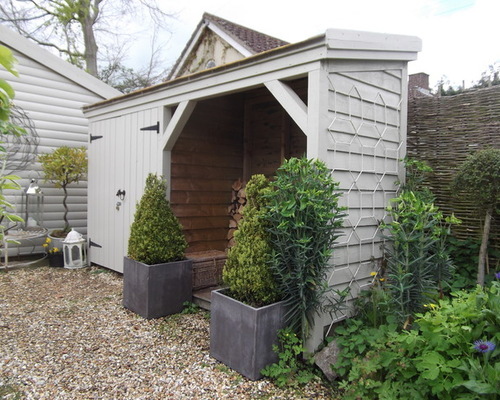
Garbage Bins 4: Beertje Vonk Artist, original photo on Houzz
Design it into an outbuilding. In a larger space, an open-sided outbuilding like this one is ideal for storing and hiding bins. It’s painted a heritage shade and is partly screened in front with evergreen topiary to create a visually appealing feature — a great way to smarten up a drab drive.
This idea would complement a traditional or cottage exterior, but if your style is more contemporary than country, you could choose a sleeker style, or paint it a darker shade to tie in with the exterior of your home.
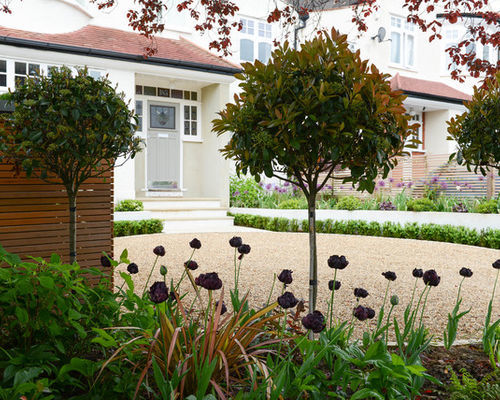
Garbage Bins 5: Kate Eyre Garden Design, original photo on Houzz
Tuck it into a border. Can you spot the trash bins on this drive? They’re neatly tucked away in the wooden box to the left of this image, and the impact of the structure has been much reduced by positioning it in a decorative floral border and planting low standard trees right alongside it.
The structure also has a green roof planted with succulents to further disguise the box and make it as visually appealing as possible.
Garbage Bins 6: The Honest Scot, original photo on Houzz
Build a clever storage wall. If space is limited, why not make your recycling containers work extra hard by turning their storage area into a boundary wall, as these smart homeowners have. This neat wooden shelter screens the bins from the road while creating a clean, contemporary-style wall.
Related: More Designer Tips to Boost Curb Appeal
By Victoria Harrison, Houzz

ECONOMIC OVERVIEW
Idaho has added 16,800 new jobs over the past 12 months, representing an above average growth rate of 2.4%. The Education & Health Services sector showed the largest annual job growth, up 4.8%. There were also strong employment gains in Construction, Government Services, Leisure & Hospitality, and Manufacturing.
In May, the state unemployment rate fell for the third consecutive month to 3.2%, underscoring the increased pressure among Idaho employers competing for workers. However, May’s unemployment drop is the result of 2,200 Idahoans exiting the workforce or ending their work search. Additionally, the reduction in the unemployment rate was also affected by the state’s labor force participation rate (the percentage of people 16 years and older with jobs or looking for work), which dropped to 63.4%—the lowest participation rate since July 1976.
HOME SALES ACTIVITY
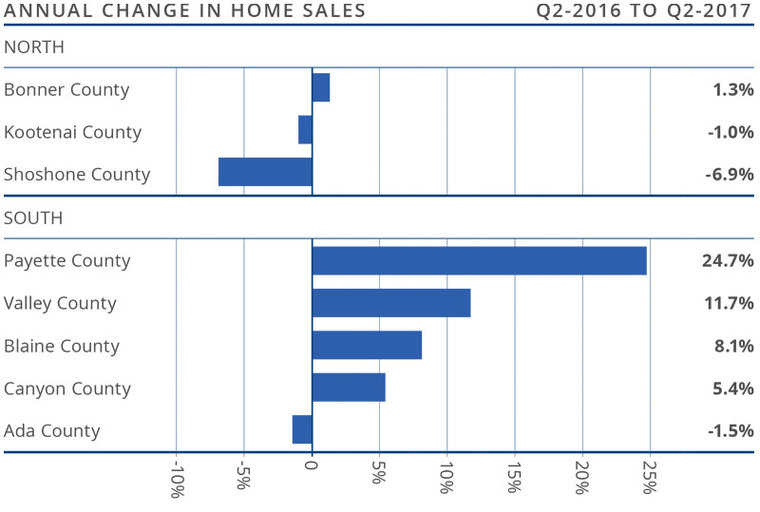
HOME PRICES
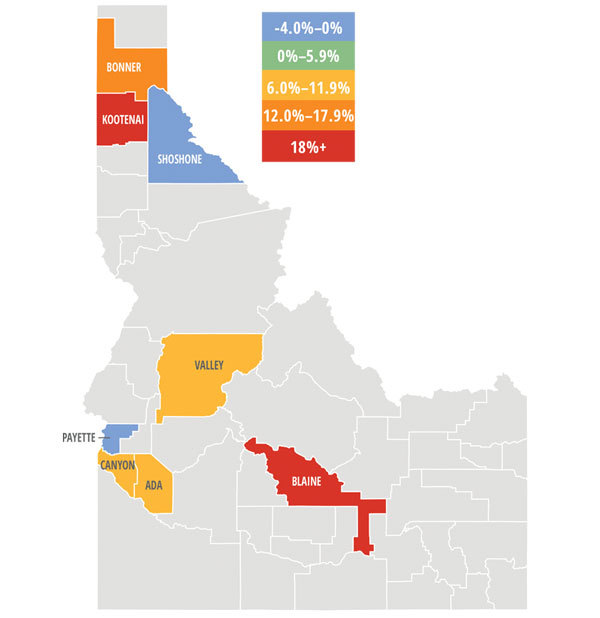 The average home price in the region rose 12.6% year-over-year to $290,811.
The average home price in the region rose 12.6% year-over-year to $290,811.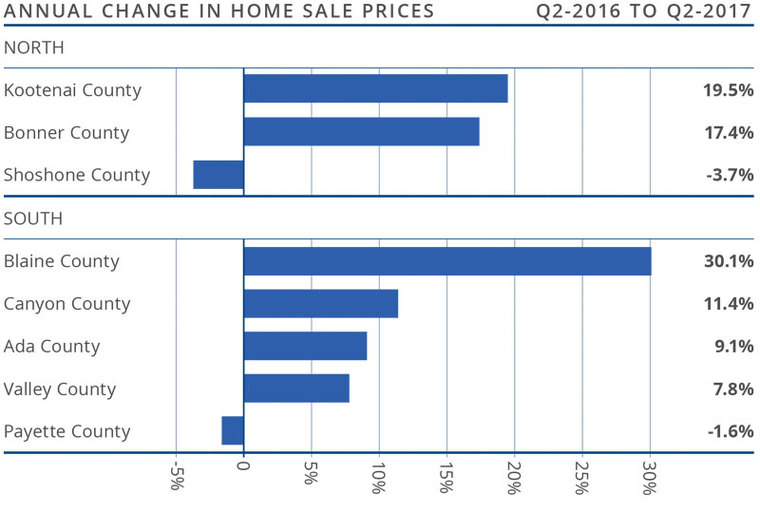
DAYS ON MARKET
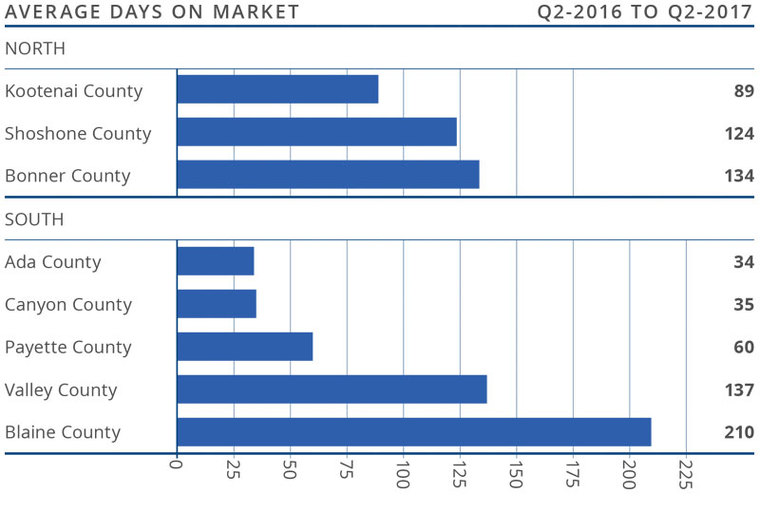
CONCLUSIONS
 The speedometer reflects the state of the region’s housing market using housing inventory, price gains, home sales, interest rates, and larger economic factors. Consumer confidence in the housing market seems to have returned, causing the markets in this report to perform well overall and for home prices to continue trending upward.
The speedometer reflects the state of the region’s housing market using housing inventory, price gains, home sales, interest rates, and larger economic factors. Consumer confidence in the housing market seems to have returned, causing the markets in this report to perform well overall and for home prices to continue trending upward.
Even as home sales have slowed in some counties, the market is tight and will likely remain that way for the balance of the year. As such, I have put the needle well in favor of sellers. While I expect mortgage rates to rise modestly through the end of this year and into 2018, they are still very low compared to historic averages. This, in concert with Idaho’s expanding economy, will continue to result in a healthy housing market.
 Matthew Gardner is the Chief Economist for Windermere Real Estate, specializing in residential market analysis, commercial/industrial market analysis, financial analysis, and land use and regional economics. He is the former Principal of Gardner Economics, and has over 25 years of professional experience both in the U.S. and U.K.
Matthew Gardner is the Chief Economist for Windermere Real Estate, specializing in residential market analysis, commercial/industrial market analysis, financial analysis, and land use and regional economics. He is the former Principal of Gardner Economics, and has over 25 years of professional experience both in the U.S. and U.K.
If you are in the market to buy or sell, we can connect you with an experienced agent here.

ECONOMIC OVERVIEW
Though Washington State’s economy has been expanding at a rapid pace, we are seeing a slowdown as the state gets closer to full employment. Given the strong economy, I expect income growth to move markedly higher in the second half of the year. I also expect the state to add around 70,000 jobs by the end of 2017.
Like much of the rest of the state, Central Washington continues to experience modest employment growth. An additional 1,300 jobs were created between May
2016 and May 2017, which drove the unemployment rate lower (from 6.3% to 5.4%). I believe we will see continued growth in employment, leading to further declines in the unemployment rate through the duration of 2017.
HOME SALES ACTIVITY
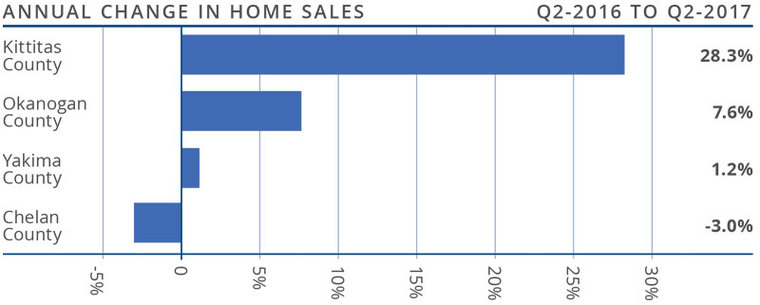
HOME PRICES
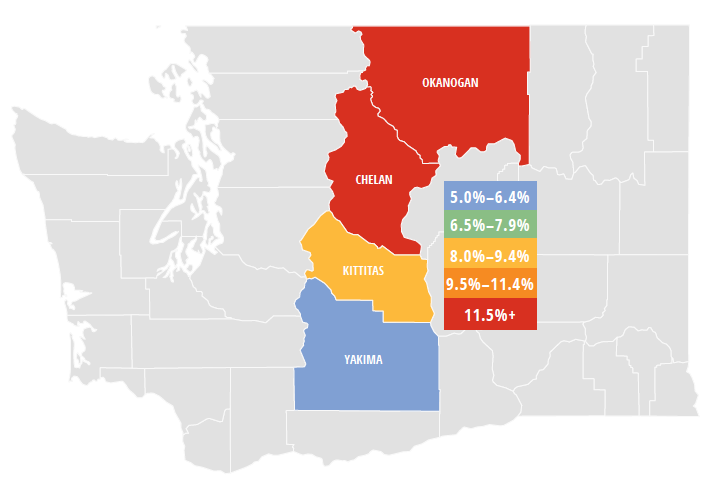 Year-over-year, the average home price in the region rose by 9.1% to $275,979. Price growth remains robust as demand exceeds supply.
Year-over-year, the average home price in the region rose by 9.1% to $275,979. Price growth remains robust as demand exceeds supply.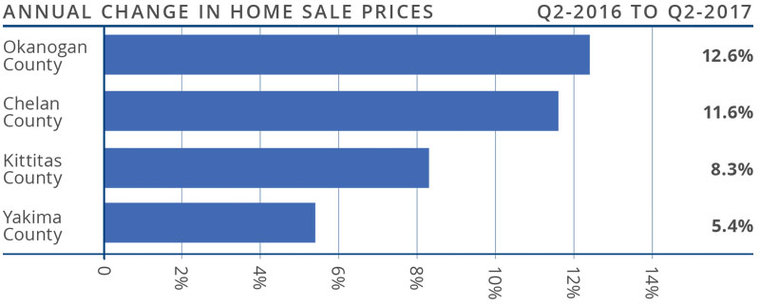
DAYS ON MARKET
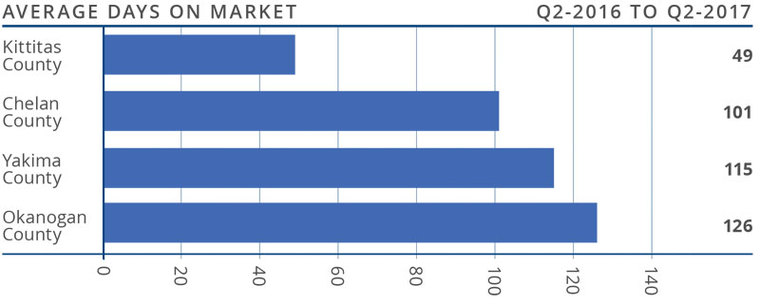
CONCLUSIONS
 This speedometer reflects the state of the region’s housing market using housing inventory, price gains, home sales, interest rates, and larger economic factors. For the second quarter of 2017, the needle is well into sellers’ territory. Prices in several markets are still trending above average and inventory issues remain.
This speedometer reflects the state of the region’s housing market using housing inventory, price gains, home sales, interest rates, and larger economic factors. For the second quarter of 2017, the needle is well into sellers’ territory. Prices in several markets are still trending above average and inventory issues remain.
I anticipate that 2017 will continue favoring sellers and demand will continue to exceed supply.
 Matthew Gardner is the Chief Economist for Windermere Real Estate, specializing in residential market analysis, commercial/industrial market analysis, financial analysis, and land use and regional economics. He is the former Principal of Gardner Economics, and has over 25 years of professional experience both in the U.S. and U.K.
Matthew Gardner is the Chief Economist for Windermere Real Estate, specializing in residential market analysis, commercial/industrial market analysis, financial analysis, and land use and regional economics. He is the former Principal of Gardner Economics, and has over 25 years of professional experience both in the U.S. and U.K.
If you are in the market to buy or sell, we can connect you with an experienced agent here.